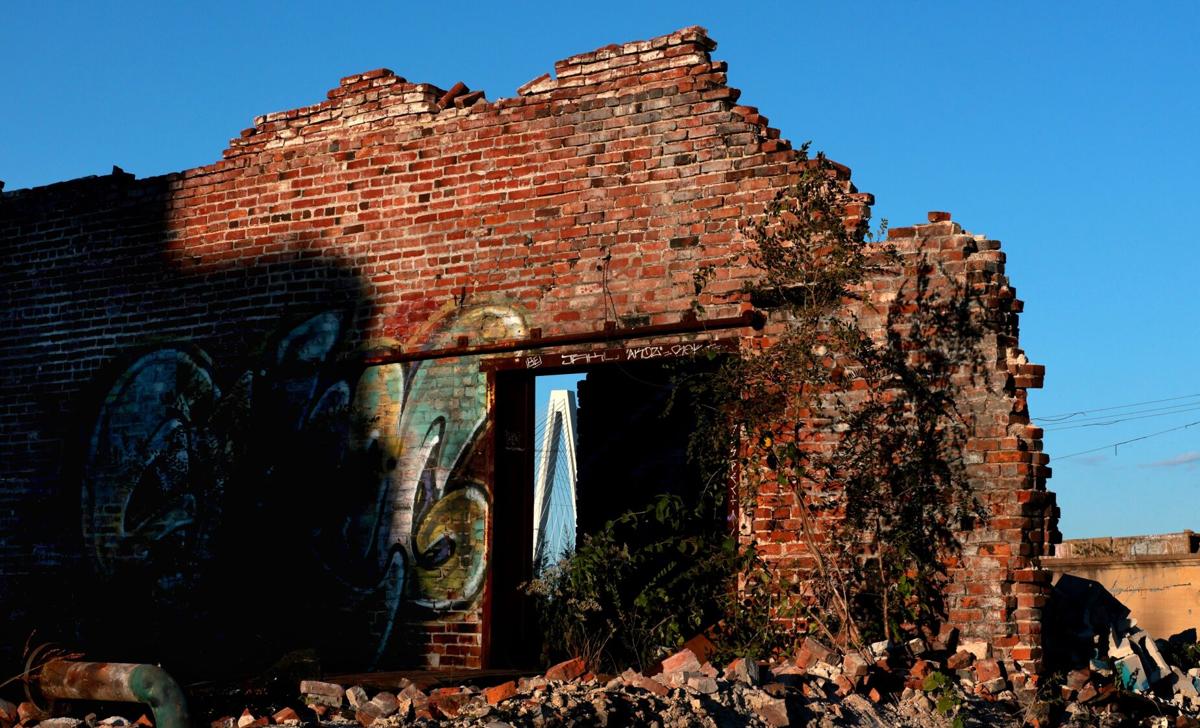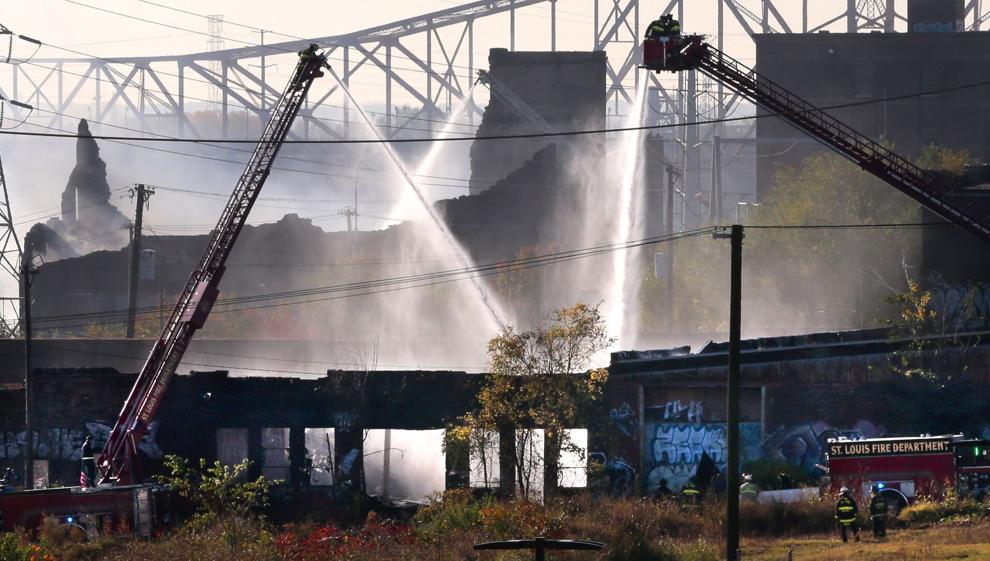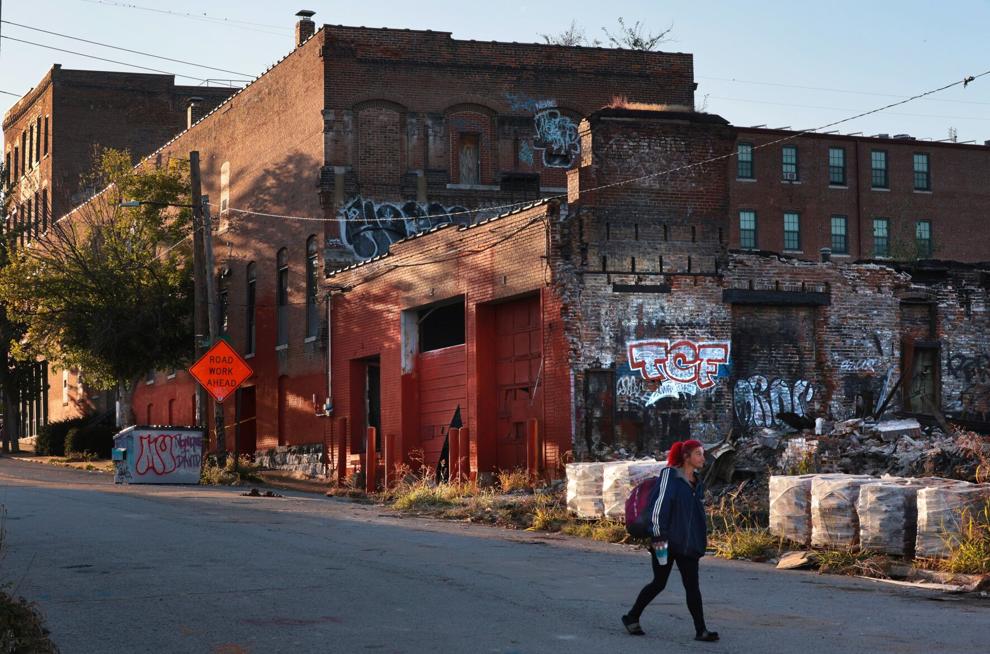Nonprofit wanted to save historic St. Louis warehouse. Then fire destroyed it.
- Steph Kukuljan Oct 12, 2023
Part of the Stan Musial Veterans Memorial Bridge can be seen through a doorway in a crumbling section of the old St. Louis Stamping Co. buildings at Cass Avenue and North First Street in the Near North Riverfront neighborhood on Monday, Oct. 9, 2023.
ST. LOUIS — The vacant warehouse complex at Cass Avenue and North First Street was anticipated to be home to a cutting-edge agricultural center that North City boosters saw as a salve for the area.
Instead, it’s slated to be another vestige of St. Louis history.
The 152-year-old site, known as the St. Louis Stamping Co. buildings, is listed on the National Register of Historic Places as the birthplace of graniteware, the iconic enamel-coated pots and pans that were sturdy and easy to clean. But multiple fires in recent years have gutted the buildings, reducing them to their brick shells.
And now their owner, nonprofit microlender and developer Justine Petersen Housing and Reinvestment Corp., has asked the city for permission to demolish the property.
St. Louis firefighters work a two-alarm fire at the former St. Louis Stamping Co. buildings at Florida and North First streets in the Near North Riverfront neighborhood on Oct. 26, 2022.
The property, which city officials condemned in 2019, poses too much of a risk to the public, said Robert Boyle, CEO of Justine Petersen. And the momentum that swelled in the neighborhood in recent years has retreated, making efforts to finance any project there nearly impossible.
“We had thought we might have had a game plan back when we purchased it,” Boyle said. “However, we are less enthusiastic about it now because there doesn’t seem to be a lot of other motivation there.”
Preservation has always been a race against the clock. But for many buildings in St. Louis, there’s little time left. It’s a critical issue here, preservationists say: When historic sites fall to the elements or to the wrecking ball, the region loses a connection to its past and also some of what could make St. Louis’ future so unique.
It’s a familiar reality for many St. Louis preservationists, who have long lamented the continued destruction of history.
“It’s a cumulative effect,” said Michael Allen, who wrote the Stamping Company’s nomination to the National Register. “Those places become extinct. And that is a loss for St. Louis.”
The Stamping Co. buildings, at 101 Cass Avenue, were built in the late 1800s as a factory for granite ironware, or graniteware, which the company invented. The products were metal coated with a distinctive speckled enamel, which had granite incorporated into it. They were lighter, stronger and more durable than other products at the time, and they helped to modernize households across the country and world.
Its founders, the Niedringhaus brothers, would later expand across the river and incorporate their own town called Granite City.
The Stamping Co. site later became a sheet metal complex, but it remains the only group of buildings associated with graniteware’s “innovative legacy,” according to the National Register nomination form. A fire destroyed the family’s historic plant in Granite City in 2003.
In the early 2000s, a developer planned to turn the St. Louis property into a concept called FarmWorks, touted as a center of aquaponics, hydroponics and vertical growing. The plan also entailed employing former convicts, who would reside at an adjacent apartment building.
But then the 2008 recession hit and foreclosures came. Plans for FarmWorks sputtered.
In 2015, a task force led by businessman Dave Peacock eyed the area as the site for a new NFL stadium, part of a plan to keep the Rams football team in St. Louis.
“It’s about the future of our region,” Peacock said at the time. “It’s about no longer accepting the notion that our assets can just dissolve in front of us, or leave.”
But those plans fell apart when Rams owner Stan Kroenke moved the team to Los Angeles anyway.
Buildings of the old St. Louis Stamping Co. are seen at the intersection of Cass Avenue and North First Street in the Near North Riverfront neighborhood on Monday, Oct. 9, 2023.
The site was donated to Justine Petersen around 2016. The nonprofit thought about developing the site for transitional housing. But costs were high and instead it banked on growing momentum — such as from the $360 million renovation of the Gateway Arch grounds just south — that never really materialized, said Boyle, the nonprofit’s CEO.
“We had expectations that there would be more aggressive development,” he said.
Mayor Tishaura O. Jones’ focus on reinvesting in the northside, details of which emerged last year, came too late for Stamping Co., Boyle said.
Fires in 2019 and 2022 destroyed the buildings’ interiors and roofs. His organization finally found the funds to pay for a $75,000 demolition, and on Friday filed for a demo permit. Apartments that front Collins Street, adjacent to the complex, would remain.
The request is currently under review by the Cultural Resources Office, which reviews all demolition requests for properties in the National Register.
“The Cultural Resources Office is in ongoing conversations with Justine Petersen to determine the best path forward,” said Meg Lousteau, its director. “The CRO will work as quickly as possible to make a recommendation.”
Allen, the preservationist, said the 2008 recession stole much of the redevelopment energy that zipped through the city at the time. In addition to the Stamping Co., other developers eyed big projects like the Railway Exchange Building that are still languishing.
“That kind of excitement for funding development hasn’t really returned in the force that it was in the early 2000s,” he said. “We’re still feeling this pause that was set in 2008,” Allen said.
Courtesy of St. Louis Post Dispatch: St. Louis wanted to save historic St. Louis warehouse. Then fire destroyed it. By Steph Kukuljan




